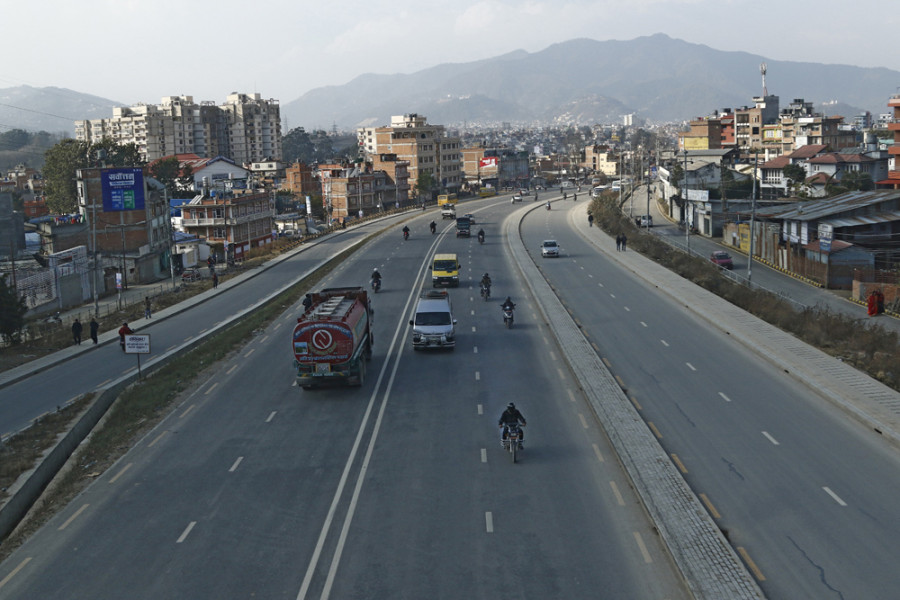Valley
China’s design plan delays Ring Road phase two project
The government’s plan to start the second phase of the Kathmandu Ring Road Improvement Project, which includes upgradation of a 82-km stretch linking Kalanki with Maharajgunj, has been delayed as the Chinese government, which is funding the project, is yet to submit the design of the project to the Department of Roads
Bibek Subedi
The government’s plan to start the second phase of the Kathmandu Ring Road Improvement Project, which includes upgradation of a 8.2-km stretch linking Kalanki with Maharajgunj, has been delayed as the Chinese government, which is funding the project, is yet to submit the design of the project to the Department of Roads.
Although the Department of Roads (DoR)—the implementing agency—planned to start the upgradation work from October last year, it did not materialise after the Chinese side, which was supposed to submit the detailed design of the project way before October, failed to keep its commitment.
“Our plan was to start the upgradation work by October 2018 and we had already initiated the process to clear the road for expansion,” said an official at the department who was associated with the project in the past. “But the Chinese side neither submitted the design nor did it communicate with us about the date for submitting the design.”
The DoR is still clueless about when the second-phase upgradation of Ring Road will start. Keshav Kumar Sharma, chief of the DoR’s Foreign Cooperation Branch, however told the Post that he would soon communicate with the Chinese side for “expediting the project”. “I am scheduled to meet with officials at the Chinese embassy in Kathmandu soon,” said Sharma. He added that during the meeting he would urge the Chinese side to submit the design as soon as possible.
Also read: Bigger, better. Can it be safer too?
When the Post approached the Chinese embassy in Kathmandu, it did not say specifically when it would submit the design.
“According to the consensus reached by China and Nepal, before the construction of second phase of China-aid Kathmandu Ring Road project, the Nepali side should first complete the land acquisition and demolition work in order to create necessary conditions for the successful completion of the project [SIC],” an official at the Chinese embassy said in response. “At present, the relevant departments of both sides are keeping communication on the project.”
However, demolition work can be started only after the design—at least a preliminary one—is ready.
During a function organised in Lalitpur on Monday to hand over the Kalanki-Koteshwor section of the ring road, Chinese Ambassador Hou Yanqi had attributed the delay in completion of the project to the land acquisition problem in particular. Prime Minister KP Sharma Oli, who attended the handover ceremony, had assured that the government would address all the issues, including land acquisition, while taking forward other projects to be funded by China.
After the recently upgraded Kalanki-Koteshwor section of the Ring Road executed under the Chinese grant drew criticism from various quarters for the absence of basic amenities like zebra crossings, dividers, traffic lights, night-lights, and properly designated bus stops, the Chinese officials expressed their unhappiness with the road officials.
The civil society and media have even termed the newly upgraded section of the road as a ‘death trap’.
“The Chinese officials are not happy with such criticism,” said a DoR official seeking anonymity because he is not allowed to speak to the media. “This might be the reason they are delaying submission of the design for the second phase.”
As per the initial agreement between the two governments, China was supposed to upgrade the road with a two-way bicycle lane and a pedestrian pathway, bus station, parking lots, construction of one simple urban flyover and three pedestrian overpasses.
However, when the Chinese side submitted the design of the first phase of the project the bicycle lane was missing. There has been a lot of criticism of late after the completion of the project, which looks sleek but is devoid of amenities required for pedestrians.
More: Police set up patrols to catch speed demons on Ring Road
Nevertheless, the source at the DoR claimed that the Chinese side shouldn’t be blamed for any shortcomings in the design of the Kalanki-Koteshwor section as it was executed only after the department approved it.
“The design was approved almost 10 years ago when the population density at the periphery of the road was not as high as it is today,” said the source. “Also our engineers who were authorised to approve the design were not exposed to the modern day design of the road project which includes adequate infrastructure for the pedestrians and cyclists.”
The DoR on the other hand is of the view that instead of criticising the upgraded road, a solution should be found. “We are planning to conduct a safety audit and implement safety measures recommended by the audit,” said the DoR source.




 19.12°C Kathmandu
19.12°C Kathmandu










